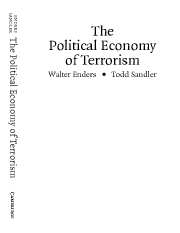Book contents
- Frontmatter
- Contents
- List of Tables and Figures
- Preface
- 1 Terrorism : An Introduction
- 2 The Dilemma of Liberal Democracies
- 3 Statistical Studies and Terrorist Behavior
- 4 Counterterrorism
- 5 Transference
- 6 International Cooperation : Dilemma and Inhibitors
- 7 Hostage Taking
- 8 After 9/11
- 9 The Economic Impact of Transnational Terrorism
- 10 Homeland Security
- 11 The Future of Terrorism
- References
- Author Index
- Subject Index
4 - Counterterrorism
Published online by Cambridge University Press: 06 July 2010
- Frontmatter
- Contents
- List of Tables and Figures
- Preface
- 1 Terrorism : An Introduction
- 2 The Dilemma of Liberal Democracies
- 3 Statistical Studies and Terrorist Behavior
- 4 Counterterrorism
- 5 Transference
- 6 International Cooperation : Dilemma and Inhibitors
- 7 Hostage Taking
- 8 After 9/11
- 9 The Economic Impact of Transnational Terrorism
- 10 Homeland Security
- 11 The Future of Terrorism
- References
- Author Index
- Subject Index
Summary
Counterterrorism consists of government actions to inhibit terrorist attacks or curtail their consequences. Such policies can limit attacks by confronting terrorists directly. For example, intelligence and police investigations resulted in the capture of the entire leadership of Direct Action (DA) in France between 1982 and 1987 (Alexander and Pluchinsky, 1992, p. 135; Hoffman, 1998). Italian authorities captured most of the Red Brigades after responding to a tip-off in the kidnapping of Brigadier General James Lee Dozier, the senior US officer at NATO's southern European command who was abducted from his home on 17 December 1981. He was freed unharmed in a daring police rescue on 28 January 1982. Based on state's evidence obtained from Antonio Savasta, captured during the raid, the police later apprehended 200 Red Brigade suspects, which resulted in further arrests and the eventual demise of the group. Other counterterrorism actions can safeguard potential terrorist targets by reducing an attack's likelihood of success or its expected payoff. The installation of metal detectors in US airports on 5 January 1973 decreased terrorists' probability of success, as did the fortification of US embassies in the mid-1970s and beyond. After 9/11, the deployment of federal screeners at US airports, the reinforcement of airplane cockpit doors, and the designation of no-fly zones in Washington, DC, and other American cities were intended to limit terrorists' success and, thereby, to prevent attacks.
The purpose of this chapter is to investigate and evaluate the two primary categories of counterterrorism policies – proactive and defensive.
- Type
- Chapter
- Information
- The Political Economy of Terrorism , pp. 84 - 110Publisher: Cambridge University PressPrint publication year: 2005

